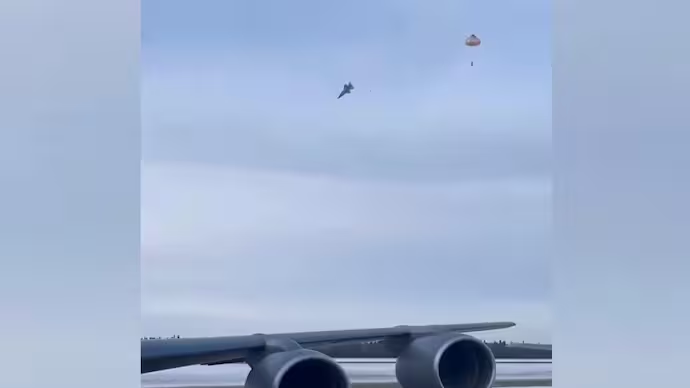F-35 Jet Crashes After Pilot’s Desperate Call
By AMERICA NEWS WORLD Staff
Published: August 29, 2025

A shocking crash shook the skies over Alaska. An F-35 fighter jet fell in flames. The pilot fought hard to save it. But nothing worked.
credit:bno news
The incident happened on August 28, 2025. At Eielson Air Force Base. The pilot took off for a routine training flight. Soon after, trouble started. The nose landing gear would not retract right. It jammed at a 17-degree angle to the left.
read this:Susan Monarez Fired from CDC: What Happened and Why?
read this:Trump and Blair Plot Gaza Rebuild – Details Inside
read this:US DHS Proposes New Visa Rules for Foreign Students
Then, the pilot tried to lower the gear again. But it stayed stuck. This tricked the jet’s sensors. They thought the plane was on the ground. While it flew high. The computer switched to ground mode. That made the jet hard to control.
However, the pilot did not give up. He called for help. A conference call with five Lockheed Martin engineers. They talked for 50 minutes. Circling the base. Trying fixes from checklists.
First, they suggested touch-and-go landings. To shake the gear loose. The pilot tried twice. But it backfired. Ice formed in the main gears too. They froze solid. Now, all landing gears failed.
Moreover, the cold weather played a big role. Temperatures hit -18 degrees Celsius. Or about 1.4 degrees Fahrenheit. Water in the hydraulic fluid turned to ice. Investigators found one-third of the fluid was water. It should have been none.
As a result, the jet became uncontrollable. The pilot had to eject. He floated down safely on a parachute. But he got minor hurts. Like a spine compression and neck scrapes. Emergency teams reached him fast.
Sadly, the F-35 hit the runway hard. It burst into a fireball. The plane was worth $196.5 million. A total loss. Video from the scene went viral. Showing the dramatic fall and explosion.
But this was not the first issue. Nine days later, another F-35 at the same base had similar hydraulic icing. That one landed okay. Lockheed had warned about cold-weather risks in 2024. In a maintenance bulletin. It said such problems could make control tough.
If the team on the call had checked that bulletin, things might differ. They could have picked a full stop landing. Or a planned eject. Instead of more touch-and-gos.
Furthermore, the report blamed more factors. Crew choices during the call. Poor oversight of hazardous materials. And bad maintenance on hydraulic barrels. The squadron used a contaminated barrel from a 2023 deployment. To Kadena Air Base in Okinawa.
The F-35 program faces big criticism. For high costs and glitches. Lifetime costs now top $2 trillion. Up from $1.1 trillion in 2018. That’s a 44% jump. Each jet costs about $81 million to buy. But running one hits $6.8 million a year. Or more.
Still, the military plans to fly them until 2088. Despite issues like this crash. The program has seen other wrecks. Like one in South Carolina in 2023. Where a pilot ejected and the jet flew alone.
Data shows rising concerns. Here’s a simple table of recent F-35 incidents:
| Year | Location | Cause | Cost Loss |
|---|---|---|---|
| 2023 | South Carolina | Pilot eject, autopilot glitch | $100 million+ |
| 2024 | Texas | Landing gear failure | Unknown |
| 2025 | Alaska | Hydraulic icing | $196.5 million |
In summary, this crash shows tech risks in harsh weather. But also human efforts to fix them. The pilot’s quick thinking saved his life. Yet, questions remain on the F-35’s reliability. And its huge price tag.
Discover more from ANW
Subscribe to get the latest posts sent to your email.
[…] F-35 Jet Crashes After Pilot’s Desperate Call […]